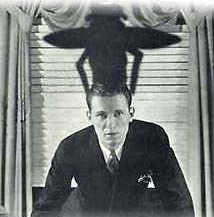
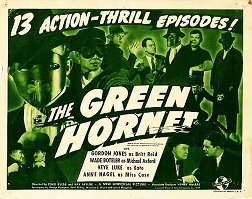 The Green Hornet (1936-1952) aired “The Make Believe sheriff” on July 4, 1944 as its 660th episode out of over 1,000. The Green Hornet was created specifically for radio by producer George Trendle and director James Jewell. The first episode aired January 31, 1936. The series proved so popular its run lasted sixteen years, with its final episode airing in late 1952. The 1940s saw two movie serials featuring the Green Hornet and his staunch ally Kato (The Green Hornet–1940, and The Green Hornet Strikes Again!–1941), which only served to heighten the popularity of the radio show. Several attempts at Green Hornet movies have been made (most recently in 2011) but none have proved as successful as the radio show (this includes the short-lived Green Hornet TV show from the 1970s, which nevertheless catapulted Bruce Lee to stardom in his role as Kato). Over its long radio run four actors were the voice of Britt Reid/the Green Hornet. From the show’s inception in 1936 through 1943 Al Hodge (1912-1979) was the voice of the Hornet (photo top right). In later years he would take on the role of Captain Video (1950-55, photo lower right) for the early television show Captain Video and His Video Rangers (1949-55), the first show of its kind on American television.
The Green Hornet (1936-1952) aired “The Make Believe sheriff” on July 4, 1944 as its 660th episode out of over 1,000. The Green Hornet was created specifically for radio by producer George Trendle and director James Jewell. The first episode aired January 31, 1936. The series proved so popular its run lasted sixteen years, with its final episode airing in late 1952. The 1940s saw two movie serials featuring the Green Hornet and his staunch ally Kato (The Green Hornet–1940, and The Green Hornet Strikes Again!–1941), which only served to heighten the popularity of the radio show. Several attempts at Green Hornet movies have been made (most recently in 2011) but none have proved as successful as the radio show (this includes the short-lived Green Hornet TV show from the 1970s, which nevertheless catapulted Bruce Lee to stardom in his role as Kato). Over its long radio run four actors were the voice of Britt Reid/the Green Hornet. From the show’s inception in 1936 through 1943 Al Hodge (1912-1979) was the voice of the Hornet (photo top right). In later years he would take on the role of Captain Video (1950-55, photo lower right) for the early television show Captain Video and His Video Rangers (1949-55), the first show of its kind on American television.
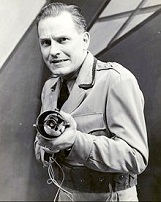
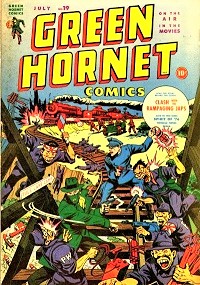 The Green Hornet’s real identity is Britt Reid, publisher of the Daily Sentinel. During a visit to the Far East, Reid saved Kato’s life. Kato now links his fortune to that of Reid as a faithful companion, driver of the Black Beauty (forerunner of the Batmobile), and all-around aide-de-camp. (Cover at left from The Green Hornet #19, July 1944.)
The Green Hornet’s real identity is Britt Reid, publisher of the Daily Sentinel. During a visit to the Far East, Reid saved Kato’s life. Kato now links his fortune to that of Reid as a faithful companion, driver of the Black Beauty (forerunner of the Batmobile), and all-around aide-de-camp. (Cover at left from The Green Hornet #19, July 1944.)
In the 1930s America was rife with criminal organizations, and not only they, but the common criminal element led to many a radio show featuring crime fighters of various stripes. Of those shows featuring crime busters with secret identities, or a special ability or power, or who employed scientific or advanced technology to thwart criminals, perhaps the most popular trio was Dick Tracy (1934-48), The Green Hornet (1936-52), and The Shadow (1937-54). To place the popularity of these “special” crime fighter shows (as opposed to straight detective or police programs, of which there were many) in some sort of perspective, the Great Depression lasted from 1929-39. During this difficult time the underworld took advantage of a ruined economy in any way it could, including bootlegging illegal alcohol during the era of Prohibition (1920-33). While this was but one enterprise crime families adopted, their schemes and violence were felt in many areas of public life. Al Capone was probably the most well known crime family boss of the time, but by the time The Green Hornet program hit the airwaves Capone was himself out of the picture, having been sent to a Florida prison in 1931, where he would die eleven years later. But crime and crime families continued without Al Capone. Scams, cons, local crime gangs, and any number of rackets bent on cheating the public or enriching one’s own pockets abounded (as they do today).
While a rather routine scenario where the Green Hornet tracks down thieves who have stolen an expensive piece of jewelry, the story rises above the norm when a young boy finds himself involved and in his own way and according to his abilities helps our masked crimefighter capture the not so smart (corny dialogue and all) criminals. Without giving away details, it struck me that the young boy is a symbol of how much has changed from the war-torn days of 1944 and how the police and the criminals they fought were viewed—and what many youth aspired to grow up to be back then—and those aspirations today. Instead of looking up to the police and wanting to grow up to be a man of the law, today many are taught that the police are the enemy, our country is the root of all evil, and wanting to grow up to be an officer of the law is frowned upon by more than a few. Looking back to 1944 when this episode aired, when America was in the midst of WW II defending its independence from forces outside its borders, and a little boy wanting to grow up to represent the side of Good in order to defeat the Bad Guys from inside our borders, makes me think the message (intentional or otherwise) of this The Green Hornet episode is a worthy one, reminding us of the foundational principles upon which we celebrate our country’s Day of Independence as seen through the eyes of “The Make Believe Sheriff” from over 75 years ago.
Tomorrow is Sunday, July 4th, 2021. Have a safe and happy holiday everyone.
Play Time: 29:31
{“The Make Believe Sheriff” aired on Tuesday, July 4th, 1944. Since it marked the middle of summer vacation for the neighborhood patriots and junior crime busters, it was no surprise to find them at the corner newsstand the next morning, some looking for the newest SF pulp while others wanted more detective or crime fighting adventures. Astounding SF (1930-present, now Analog) was not to be missed, as it was the premiere science fiction magazine in the field and would be for many years to come. It was a monthly in 1944. The Phantom Detective (1933-53) was one of several pulps trying to cash in on the popularity of The Shadow magazine. It enjoyed notable success for 20 years and even outlasted The Shadow by a couple of years (though publishing bi-monthly instead of monthly, as did The Shadow). The Shadow (1931-49) was the progenitor of such pulp heroes as The Green Hornet (radio) and The Phantom Detective (magazine). Before the character of the Shadow was given his own magazine, he was only the narrator of a radio program titled Detective Story Hour which debuted in July of 1930. (Curiously enough this was the same year as Astounding SF first appeared.) The mysterious Shadow narrator became so popular that his character was given its own magazine in April of 1931, the publisher being Street & Smith, the same magazine publisher who happened to have foresight enough to give the relatively new science fiction genre a chance by publishing Astounding SF. Needless to say, the Shadow character hit the jackpot and was featured not only on radio, but in magazines, comic strips, comic books, television, video games, and 5 feature films. The magazine was a monthly in 1944.}
[Left: Astounding, July 1944 – Center: Phantom Detective, June 1944 – Right: The Shadow, July 1944]
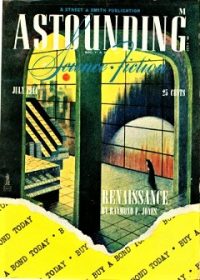
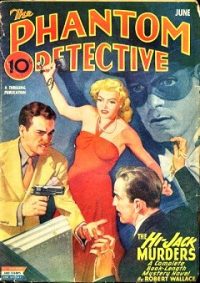
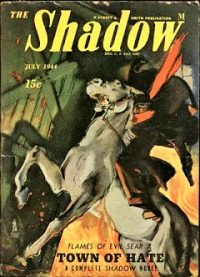
To view the entire list of weekly Old Time Radio episodes at Tangent Online, click here.